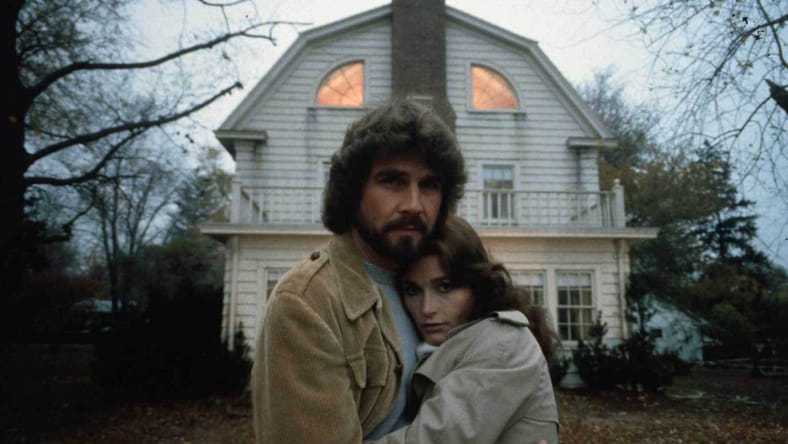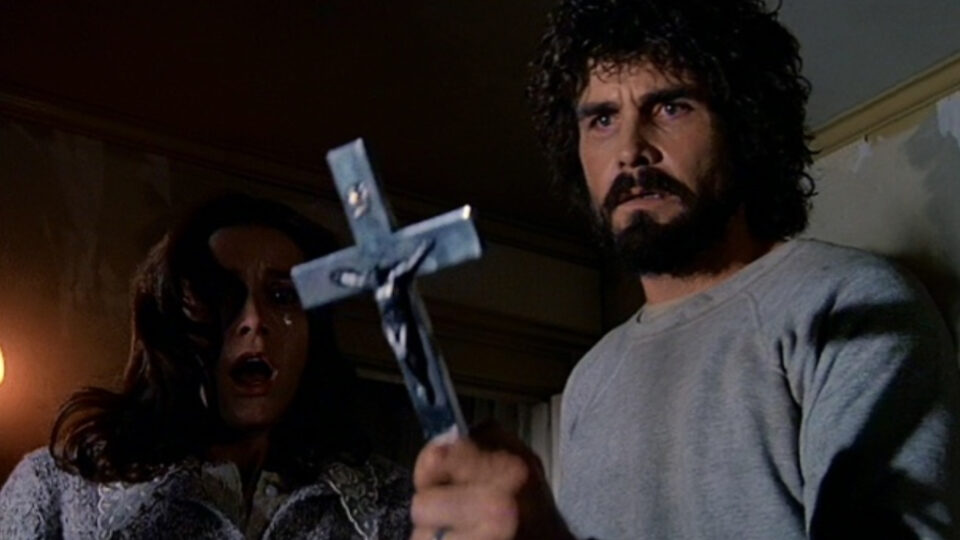Lalo Schifrin’s Infectiously Great Score for ‘The Amityville Horror’ [Terror on the Turntable]

Welcome to Terror on the Turntable! In this monthly column, join Rachel Reeves as she explores the powerful and unholy alliance between horror films and their scores. Covering only scores released on vinyl, it’s a conversation about the intersection of music theory, composer style, film history, and the art of deep listening. So, light the candles, put on your headphones, and get ready to drop that needle. The sacred ritual of listening to music on wax is about to begin. For this installment, Rachel gets fired up about Lalo Schifrin’s score for The Amityville Horror.
Author’s Note: While it is cliché to start any piece with a quote, it is sometimes the path of least resistance, so please, forgive me. *clears throat*
Mark Twain once said, “History doesn’t repeat itself, but it often rhymes.” While the constantly shifting sands of today’s hyper-divisive political atmosphere can feel particularly infuriating and unprecedented, many parallels exist between our current climate and the one America experienced in the 1970s. Familiar concerns about the loss of religion and the breakdown of the “traditional” family ran rampant within a segment of the populace and influenced many horror films of the time. One such film, which just happens to be celebrating an anniversary this month, is Stuart Rosenberg’s 1979 film, The Amityville Horror.
Loosely based on the loosely true story of the Lutz family, The Amityville Horror chronicles the family’s tumultuous 28-day occupancy of their new home, which was once the scene of the brutal DeFeo family murders. Starring James Brolin and Margot Kidder as George and Kathy Lutz, the film’s themes align with contemporaries like The Exorcist, Rosemary’s Baby and The Omen. Though similarly filled with devils, murder, religion, and unexplained phenomena, Rosenberg relied less on explicit effects and more on atmosphere, character dynamics and implication.
Before filming started, Rosenberg called in composer Lalo Schifrin to help support this approach. Pre-Amityville, Rosenberg and the Argentina-born Schifrin had worked together on Cool Hand Luke, Voyage of the Damned, WUSA, and Love and Bullets. Rosenberg knew a strong score would be critical to selling the horror and that Schifrin had the skills to deliver. A prolific composer, pianist, and conductor, Schifrin’s concert hall-worthy technique and deep background in jazz have made him one of the most influential film composers ever. Some of Schifrin’s major film score hits include Bullitt, Dirty Harry, Enter the Dragon, and the Mission: Impossible theme. He also wrote an entire score for The Exorcist that, ultimately, got thrown out for being too scary. Wild, right?

There’s Nothing Like It On The Market
Much like a movie, building a house requires many skilled professionals and a solid foundation. Without those key elements, the whole thing could crumble. For Schifrin, he took this idea and the house at the heart of The Amityville Horror and used it as inspiration to build the entire score. Fully embracing the idealized American ideal of “home” and the Lutz family’s initial perception of the Amityville house, Schifrin came up with a lilting, playful, Jaws-like, two-note melody sung by sopranos. On another, much darker level, it also served as a voice for the murdered DeFeo children whose spirits lingered.
“I got an idea that the house was alive – there was something alive in the house, and I got the idea of doing a nursery rhyme, almost like children’s voices, but more eerie. They were like bricks with which I built a whole house – the Amityville house! It was the bricks of a score, little musical cells.”
– Lalo Schifrin, 1983, CinemaScore
Introduced during the opening title sequence, the “Amityville Horror Main Title” opens with sustained strings, simple piano, ethereal harp, and innocent, lullaby-like vocals. Openly whimsical, Schifrin then counters the childlike melody with low, brooding strings, subtle tonal shifts, and unsettling extended techniques. Coupled with a static shot of the house, the dramatic dichotomy instantly associates the theme with the house itself and its dark secrets.
Houses Don’t Have Memories
Building upon that initial idea, Schifrin continuously evolves, reworks, and recontextualizes those two notes throughout the film. For example, in the track “Get Out,” Schifrin uses trumpets, brass and woodwinds, and vocals to present the leitmotif. In “The Wind,” Schifrin plays with rhythm and composition complexity while using brass and strings to deliver the tune. Then, in “The Ax,” dissonant amalgamations of juxtaposed instruments present what was once innocent in a terrifying new context (complete with an intentional nod to Psycho).
Continuously revisiting and reutilizing this easily recognizable melodic segment serves the story in multiple ways. For one, the frequent repetition builds tension by allowing us to chart the Lutz family’s awareness, growing paranoia, and George’s downward spiral. Just like how George bolts awake a little differently every morning at 3:15 am, the musical phrase doesn’t repeat itself but often rhymes. Similarly, the repetition reinforces the growing malevolence within the house and its infectious ability to poison everyone who passes through its front door.

For God’s Sake, Get Out!
Compared to many horror films released around the same time, The Amityville Horror relies more on psychological torment and an invisible feeling of dread than outright horror and violence. Understandably, this is considered by many to be one of the biggest flaws of the film. However, what this intentional approach does is really highlight the strength and importance of Schifrin’s score.
In the same way that Harry Manfredini’s score for Friday the 13th tips us off to Voorhees’ presence and the way John Williams’ score embodies the stealthy, lurking shark in Jaws, Schifrin’s score fills the gap between the visual and the narrative. By cleverly cementing the association between the music and the house early on, Schifrin can subtly manipulate the film’s emotional undercurrent as needed. While there are certainly moments of lightness, as is evident in the track “Amityville Love Scene,” Schifrin was not afraid to crank up the horror when the appropriate time came.
Careful not to tip his hat too soon, Schifrin places discordant, wrong-sounding notes strategically to subconsciously illicit doubt. Then, as aggressions become openly bold and undeniable, Schifrin demonstrates his impressive ability for nasty, controlled chaos. In select passages, a crystallophone and a waterphone emphasize the otherworldly element through their less recognizable, highly unique sound. With “The Basement,” “Screams,” “The Crucifix,” and “Bleeding Walls,” big swells of brass accent the alarming, incontrovertible evidence while vigorous, atonal strings maintain unease. Despite almost always using the original leitmotif as an ingredient, each track retains its own individually captivating flavor.
What I Felt There Was Real, and What I Heard There Was Real!
Upon its initial theatrical release, The Amityville Horror exceeded all initial expectations. A relatively small production distributed by American International Pictures, the film would earn nearly twenty times its budget and became the second-highest-grossing film of 1979. Audiences were enticed by the film’s real-world roots and could identify with the Lutz family’s anxiety and excitement surrounding homeownership. Stephen King even called the film “a financial demolition derby,” reversed his initial thoughts on it, and prominently featured it in his 1981 book, Danse Macabre.
Schifrin also received proper attention for his work on The Amityville Horror, garnering critical and mainstream acclaim for his score. Achieving a to-this-day rare feat, Schifrin earned an Academy Award and a Golden Globe Award nomination for Best Original Score. Though ultimately losing the Oscar to George Delerue for A Little Romance, the fact that a truly frightening horror score was nominated remains impressive. Even now, nearly 50 years later, Schifrin’s score for The Amityville Horror is a hauntingly effective work and a shining example of a score’s power.
Crate Digging
Immediately released on vinyl in 1979, the Casablanca LP contains a relatively small collection of Schifrin’s music. However, what it does contain is the absolutely bananas disco cover of the classic Amityville theme titled “Amityville Frenzy.” Obnoxiously 70s, over-the-top, and incredibly delightfully cheesy, “Amityville Frenzy” is a must for any proper Halloween costume party or playlist.
There have also been a few CD releases of the score. However, if you’re going to spring for a CD copy, save up and splurge on the Quartet Records impressive 2-CD, Limited Edition, Remastered, and Expanded release. More comprehensive and complete than any other release, it is also the best-sounding one out there. I mean, if you’re going to do it, do it right, right?
Categorized:Editorials Terror On The Turntable

